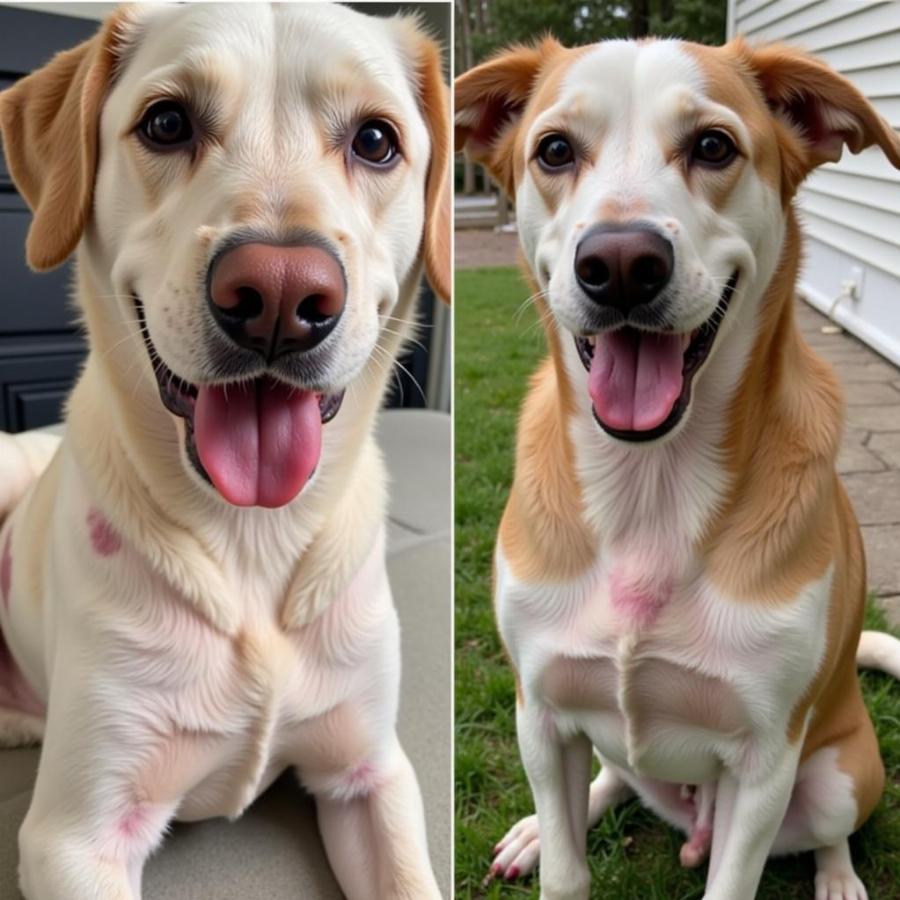Mange in dogs is a common skin condition caused by microscopic mites. It can cause intense itching, hair loss, and skin inflammation. If your dog is exhibiting these symptoms, a mange dip might be necessary. This article will provide a comprehensive guide to mange dips for dogs, including types, usage, safety precautions, and alternative treatments. Understanding how to effectively and safely use a mange dip is crucial for your furry friend’s well-being.
Understanding Mange in Dogs
Mange isn’t a single disease but rather a group of skin conditions caused by different types of mites. The two most common types are demodectic mange (caused by Demodex canis mites) and sarcoptic mange (caused by Sarcoptes scabiei mites). Demodectic mange is often localized and less contagious, while sarcoptic mange, also known as scabies, is highly contagious and can spread quickly among dogs and even to humans. Recognizing the type of mange is crucial for choosing the right treatment approach.
What is a Mange Dip?
A mange dip is a concentrated solution designed to kill the mites responsible for mange. These dips typically contain insecticides or miticides, such as amitraz, lime sulfur, or permethrin. They are diluted with water and applied to the dog’s entire body, ensuring thorough coverage to effectively eliminate the mites.
Types of Mange Dips
Several types of mange dips are available, each with its own active ingredient and effectiveness against specific types of mites. Amitraz dips are commonly used for demodectic and sarcoptic mange. Lime sulfur dips are a more traditional option, effective against both types of mange and certain fungal infections. Permethrin dips are also used for various mite infestations but should be used cautiously as they can be toxic to cats and some dog breeds.
How to Use a Mange Dip Safely
Using a mange dip requires careful preparation and adherence to safety guidelines. Always consult your veterinarian before using any mange dip on your dog. They can diagnose the specific type of mange and recommend the most appropriate and safe treatment. Follow their instructions carefully, including the proper dilution ratio and application method. Protect yourself by wearing gloves and consider eye protection. Keep the dip away from your dog’s eyes, nose, and mouth. Ensure thorough rinsing after the recommended contact time to prevent any residual effects.
What if My Dog Licks the Mange Dip?
If your dog ingests a small amount of the diluted dip, it might experience mild gastrointestinal upset like vomiting or diarrhea. Monitor your dog closely and contact your veterinarian if these symptoms persist or worsen. For larger ingestions or concentrated dips, immediate veterinary care is critical.
Alternative Treatments for Mange
Besides mange dips, other treatment options are available. These include oral medications, topical treatments, and injectable medications. Your veterinarian can recommend the best approach based on the type of mange, your dog’s overall health, and other factors.
Home Remedies for Mange
While some home remedies are suggested for mange, it’s essential to consult your vet before trying them. Some natural oils, like neem oil, might offer some relief from itching and inflammation, but they shouldn’t replace veterinary-prescribed treatments.
 Dog Recovering From Mange
Dog Recovering From Mange
Preventing Mange in Dogs
Maintaining good hygiene, regular grooming, and avoiding contact with infected animals can help prevent mange. Regular veterinary checkups can also help identify and address any potential skin issues early on.
Conclusion
Mange dips can be effective in treating mange in dogs, but their use requires careful consideration and veterinary guidance. Understanding the different types of mange, dips available, and safety precautions is essential for ensuring your dog’s safety and the treatment’s effectiveness. Always consult your veterinarian for the best course of action and explore alternative treatments if necessary. With proper care and treatment, your furry friend can recover from mange and return to a healthy, happy life.
FAQs about Mange Dip for Dogs
- How often should I dip my dog for mange? The frequency of dips depends on the type of mange and the specific product used. Always follow your veterinarian’s instructions.
- Can I use a human mange treatment on my dog? Never use human medications on your dog without consulting a veterinarian. Human and animal formulations differ significantly and can be dangerous if misused.
- Are there any side effects of mange dips? Some dogs might experience temporary skin irritation, dryness, or redness after a mange dip. If these symptoms persist or worsen, contact your veterinarian.
- Can mange dips be used on puppies? Certain mange dips are not suitable for puppies or pregnant dogs. Consult your veterinarian for safe and effective options for young or pregnant dogs.
- How can I prevent my other pets from getting mange? Isolate the infected dog from other pets in the household until the treatment is complete. Thoroughly clean and disinfect shared bedding, toys, and other items.
- How long does it take for mange to clear up after using a dip? The recovery time varies depending on the severity of the infestation and the dog’s overall health. It can take several weeks or even months for the skin and fur to fully recover.
- Can mange be cured completely? Yes, with proper treatment and care, mange can be cured. However, chronic cases of demodectic mange might require ongoing management.
Related Articles You Might Find Helpful
Beaut Dogs is your trusted source for comprehensive and reliable information about the world of dog breeds. We provide expert advice on dog care, health, training, and nutrition to help you give your furry friend the best possible life. When you need assistance, contact us via Email at [email protected] for detailed and accurate answers from our Beaut Dogs experts.